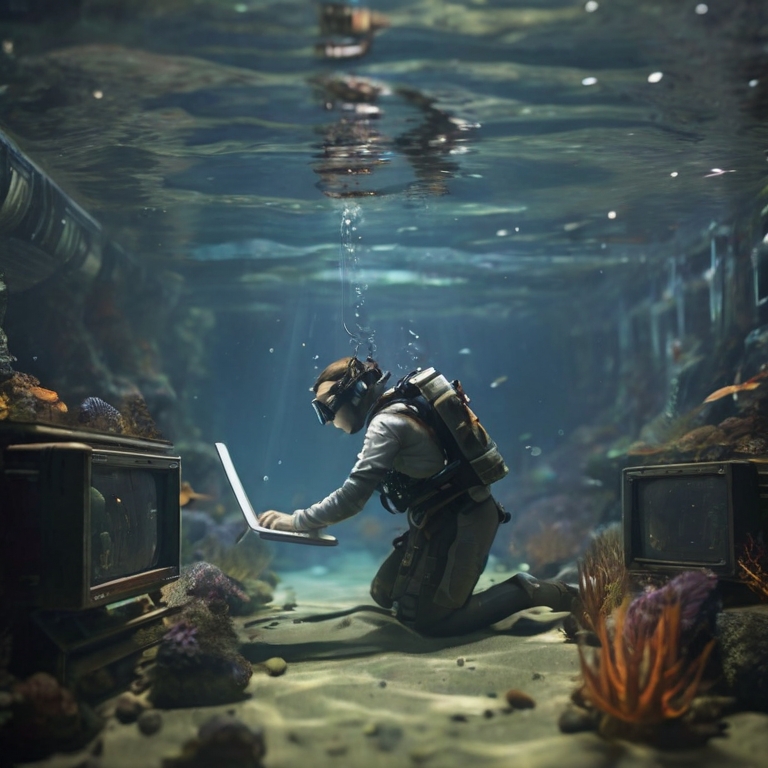In a world where technology shapes our daily lives, programming has become a ubiquitous skill, valued in traditional office settings and unexpected, unusual environments. These unique environments challenge developers to adapt and innovate, pushing the boundaries of what we believe is possible with code.
Underwater Coding Challenges

The underwater environment presents an extraordinary set of challenges for programmers, with its distinct and dynamic environment becoming a proving ground for innovative coding solutions. The developers engaged in this field are required to design software that enables autonomous underwater vehicles (AUVs) and remote-operated vehicles (ROVs) to function in environments that are as unpredictable as they are inaccessible. Real-time analysis and decision-making capabilities are important for these underwater robots, as they must independently navigate through complex terrains, avoid obstacles, and carry out scientific missions with minimal human intervention.
This demand for sophisticated programming goes beyond what is typically encountered on the surface as marine conditions exert profound effects on operational conditions. When programming for submersible technology, careful consideration of the immediate environment – including relentless water pressure, fluctuating temperatures, and varying salinity levels – is imperative. These factors can influence sensor readings and the physical performance of the hardware, and as such, must be meticulously modeled and incorporated into the software. Developers must implement complex data processing algorithms that can sift through the noise and ensure the integrity and reliability of the data collected.
Real-time processing is important in underwater operations where the window for responding to data inputs is limited. For example, AUVs undertaking seabed mapping need to process sonar and lidar inputs quickly to navigate effectively and avoid collisions. In biological sampling, the ability to promptly process visual and sensor data can be the difference between capturing a rare ecological event or missing it entirely. Understanding these subtleties drives developers to optimize their code for speed and efficiency and build in adaptive features that let AUVs respond to their environment in real-time, leveraging models and machine learning to refine their behavior based on incoming data.
The advancements in underwater coding hold the potential to revolutionize marine exploration and research, facilitating more nuanced and extensive studies of the ocean’s depths than ever before.The frontier of underwater software development is about creating intelligent, autonomous systems that can uncover secrets of the deep while navigating its challenges with a precision that mimics the best capabilities of human divers and pilots.
Space as The Final Frontier for Coders
From the depths of the ocean to the vastness of space, programming knows no bounds. Space environments present a set of challenges not found on Earth, like zero-gravity, extreme temperatures, and cosmic radiation, all of which can wreak havoc on electronic systems.
Creating software for space missions requires thorough testing and an emphasis on reliability and redundancy. Code that controls satellites, rovers, and other spacecraft must be meticulously written to ensure it can withstand the harsh conditions of space without the possibility of immediate human intervention. The Curiosity rover, for example, is a masterclass in autonomous operation and systems resilience—an inspiration for programmers tackling difficult tasks.
Battlefield Coding
On the battlefield, the role of programming is more important than ever. Military operations often employ software for communication, reconnaissance, and even direct engagement with the enemy through unmanned systems.
Coding for such high-stakes environments requires a keen understanding of security, durability, and adaptability. Software must be able to withstand cyber threats, extreme physical conditions, and be versatile enough to accommodate rapidly changing scenarios. Coders in this domain often work on secure communication systems, real-time data analysis tools, and autonomous weaponry, putting their skills to the test in life-or-death situations.
High-Speed Programming: Code at the Speed of Sound
When vehicles push the limits of speed, the software that helps manage that speed becomes critical. Whether it’s in Formula One or aboard high-speed trains, the systems involved require incredibly responsive and reliable programming to ensure safety and efficiency.
The data processing systems in these environments gather information from numerous sensors at breakneck speeds, demanding exceptional performance from both the hardware and the software. Minimal latency and peak efficiency are matters of performance and safety. Here, programmers must pursue elegant solutions that perform flawlessly under the pressure of high velocity.
Coding for Medical Miracles
Perhaps one of the most intricate environments for programming is within the human body. Medical technology, particularly devices like pacemakers, insulin pumps, and brain-machine interfaces, relies heavily on software to operate effectively and adapt to the complex requirements of human biology.
Medical programmers face the task of integrating their code with life-sustaining equipment that must perform with the utmost precision. As with space coding, there’s a premium on reliability because the cost of failure is measured in human lives. This involves extensive testing and a profound understanding of both the technology and the biological systems they interface with.
Augmenting Nature
Programmers are found in human-made environments and also in the wild, implementing technological solutions to monitor and protect wildlife. Conservation technology includes the use of drones, tracking devices, and automated camera traps that require firm programming to handle unpredictable natural settings.
Developing software to collect and analyze data on animal behaviors, migrations, and populations involves writing code that can endure the unpredictability of natural habitats. This also encompasses the challenges of providing software updates in remote areas and ensuring long battery life for devices used in the field.
Crafting Code for Creativity
The world of art provides an unexpected canvas for programming. Interactive art installations, immersive theater experiences, and digital music require the seamless integration of technology and creativity. Programmers in this field must cater to artists’ visions while ensuring the technical aspects are sound and reliable.
In these environments, programming meets aesthetics, and the functional merges with the experiential. Each project is a test in adaptability and user experience design, creating a space where code becomes an integral part of the storytelling process.